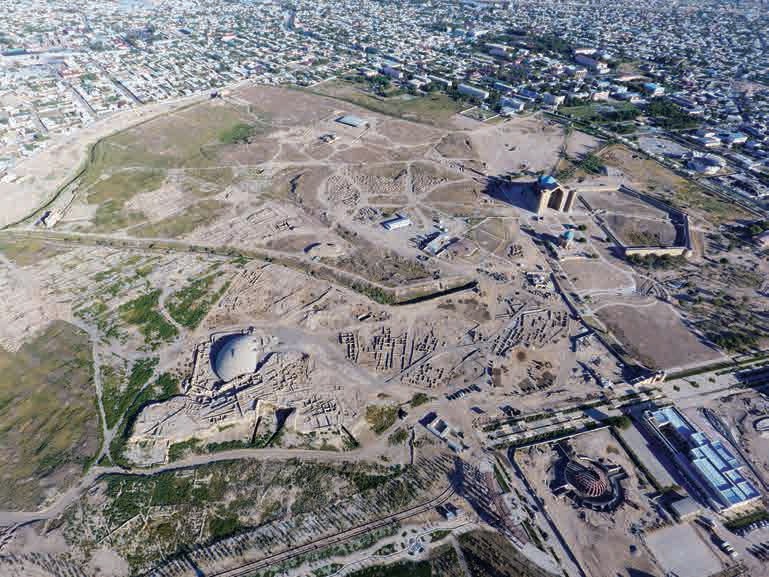STUDYING of the PECULIARITIES of the FARMING of the POPULATION of the MEDIEVAL KULTOBE SITE: according to archaeozoological analysis (2020–2021)
DOI:
https://doi.org/10.52967/akz2021.3.13.108.133Keywords:
archaeology, Turkestan region, medieval settlement of Kultobe, archaeozoology, osteology, osteometry, medieval fauna, cattle breeding, diet, ritualsAbstract
The article analyzes the results of the conducted archeozoological studies, based on materials collected during the archaeological excavations of the medieval settlement of Kultobe during the period from 2020 to 2021. The osteological material was studied and grouped by animal species, skeletal elements and age characteristics. 3815 bones were studied, of which 3197 bones were determined. The remains of small cattle make up 62,4%, cattle – 17,1%, horses – 15,6%. The bones of camel, donkey, dog, kulan, saiga, argali and birds were found. The role of hunting in the economy of the inhabitants of the settlement was insignificant. During the morphometric analysis of animal bones, it was found that a number of animals have anatomical features. Among the osteological materials, a large number (more than 800) of shoulder blades were identified, and all of them belonged to small cattle. The shoulder blades of this species were found on several objects in a grouped form and, for the most part, traces of “cuts” and “punctures” were preserved on them. The mass discovery of the scapular bones of small cattle is associated with the rite of “divination on the scapula”. The excavated objects date back to the XVIII–XIX centuries. In the Russian archeozoological science, osteological materials from the cultural layers of monuments dating from such a late time were not previously considered. The study of osteological materials found at the Kultobe settlement is relevant in determining the dynamics of the growth of the number of animals in the economy of the population of the Turkestan region, anatomical features and rituals associated with animal bones.
References
Akaevskiy, A. I., Yudichev, Yu. F., Seleznev, S. B. 2005. Seleznev, S. B. (ed.). Anatomiya domashnikh zhivotnykh (Pet Anatomy). Moscow: “Akvariym-Print” (in Russian).
Akymbek, E. Sh., Shagirbayev, M. S. 2021. In: Kazakhstan Archeology, 1 (11), 72-100 (in Kazakh).
Witt, V. O. 1952. In: Sovetskaya arсheologiа (Soviet archeology), XVI, 163–206 (in Russian).
Gaiduchenko, L. L. 2014. In: Kompleksnyye issledovaniya gorodishcha Jankent (raboty 2011–2014 gg.) (Comprehensive studies of the Jankent town (works 2011–2014)). Almaty: “Arys” Publ., 161–178 (in Russian).
Erokhin, N. G., Bachura, O. P. 2011. In: Tataurova, L. V. (ed.). Metodika mezhdissiplinarnyh arheologicheskih issledovaniy (Methodology of interdisciplinary archaeological research). Omsk: “Nauka” Publ., 62-69 (in Russian).
Kosintsev, P. A. 2017. In: Samashev, Z. (ed.). Ancient sanctuaries of Ustyurt and the Eastern Aral Sea region. Almaty: A.Kh. Margulan Archeology Institute, 301-319 (in Russian).
Kosintsev, P. A., Gimranov, D. O, Loman, V. G. 2020. In: Abuseitova, M. K. (ed.). Istoriya i kultura Velikoy Stepi (History and culture of the Great Steppe). Almaty: “Shygys pen Batys” Publ., 200-205 (in Russian).
Mezhdunarodnaya veterinarnaya anatomicheskaya nomenklatura na latinskom i russkom yazykah. 2013. (International Veterinary Anatomical Nomenclature in Latin and Russian). 5-ed.: Translation and Russian terminology by Prof. Zelenevskiy, N. V. Saint Petersburg: “Lan” Publ. (in Russian and Latin).
Shastin, N. P. (ed.). Puteshestvie v vostochnye strany Plano Karpini i Gilioma de Rubruka. 1957. (Travel to the eastern countries of Plano Carpini and Guillaume de Rubruk). Moscow: State-Publishing House of Geographical Literature (in Russian).
Radlov, V. V. 1989. Iz Sibiri (From Siberia). Moscow: “Nauka” Publ. (in Russian).
Savelyeva, T. V., Shagirbayev, M. S. 2020. In: Vestnik KazNPU im. Abaya. Seriya «Istoricheskiye i sotsialno-politicheskiye nauki» (Bulletin of Abay Kazakh National Pedagogical University. Series «Historical and socio-political sciences»), 1 (64), 390–400 (in Russian).
Smagulov, E. A. 2017. Drevnii Turkestan: shtrihi k istoricheskomu portretu (Ancient Turkestan: touches to a historical portrait). Almaty: A.Kh. Margulan Archeology Institute (in Russian).
Khazbulatov, A. 2020. In: Nauchnyi otchet po proektu «Restavrasia istoricheskih obektov gorodishcha Kultobe» za 2020 god (Scientific report on the project “Restoration of historical objects of the settlement of Kultobe” for 2020). Book 1. Nur-Sultan (in Russian).
Khinayat, B. 2001. In: Otan tarihy (History of the homeland), 1, 119-122 (in Kazakh).
Salkin, V. I. 1967. In: Blleten moskovskogo obestva ispytatelei prirody. Otdel biologii (Bulletin of the Moscow Society of Nature Testers. Department of Biology), LXXII (1), 114-124 (in Russian).
Shagirbayev, M. S. 2020a. In: Kazakhstan Archeology, 1 (7), 161-166 (in Kazakh).
Shagirbaev, M.S. 2020б. In: Kulturnoe nasledie (Сultural heritage), 4. 115-128 (in Russian).
Shagirbaev, M.S. 2020в. In: Kazakhstan Archeology, 2 (8), 145-149 (in Kazakh).
Shagirbayev, M. S., Sorokin, D., Kazizov, E. S., Maryksin, D. V., Bychkov, V. S. 2021. In: Kulturnoe nasledie (Сultural heritage), 2 (93). 23-47 (in Russian).
Driesch, A. V. 1976. In: Preabody Museum of Archeology and Ethnology Harvard University. Cambridge, Bulletin 1, 21–101 (in English).
Eisenmann, V., Karchound A. 1982. In: Bulletin du Museum national histoire naturelle. Paris, 4 (1/2), 75-103 (in English).
Silver, I. A. 1970. In: Science in archaeology: a survey of progress and research, 2nd edition. New York: Prager Publishing, 283-302 (in English).

Downloads
Published
How to Cite
Issue
Section
License
Copyright (c) 2021 Shagirbayev Mambet, Erzhіgіtova Aisulu, Kazizov Erlan, Sorokin Denis

This work is licensed under a Creative Commons Attribution-NonCommercial 4.0 International License.






